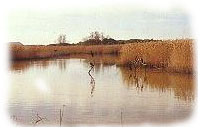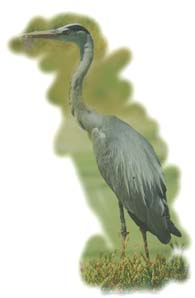| Roman Coastal Reserve | | | Zones | | | The River Tiber |
 |
The River, after many decades of maltreatment, is recovering its charm remaining a big natural attraction. Thanks to the efforts of the city administration for the purification of the urban unloading, a great variety of fishs such as bleaks (Alburnus Alburnus), rudds (Scardinius erythrophthalamus), Crucian carps (Carassius carassius), numerous eels (Anguilla anguilla), carps and mullets have returned to populate the waters of Tiber. However, sturgeons(Acipenser sturio) which, went up the course of the river once, never came back. |
| On the banks, vegetation
continues the complete aspect and gives hospitality to various birds such
as the Grey Heron (Ardea cinerea), the Little Egret(Egretta
garzetta), the Night Heron(Nycticorax nycticorax).
We can observe easily the Penduline Tit (Remiz pendulinus),
the Moustached Warbler (Acrocephalus melanopogon) and the
Reed Warbler (Acrocephalus scirpaceus) in the reed. It is
often possible to see the opening gallery hosting the
Kingfisher's nest
(Alcedo atthis) on the banks in landslide.
Along the muddy banks the Snipe (Gallinago gallinago), the
Common Sandpiper (Actitis hypoleucos), the Little Stint
(Calidris minuta), the Black-winged Stilt(Himantopus himantopus),
stop themselves during migrations. During the winter months thousands of
Cormorants (Phalacrocorax carbo) anchor towards the final
part of the river.
In the zones between the embankment and the course of the river there are Foxes, Least Weasels, Porcupines, and a lot of birds such as the Stonechat (Saxicola torquata), the Spotted Flycatcher (Muscicapa striata) and the Chiffchaff (Phylloscopus collybita). During autumn and winter the flock of Greylag Gooses(Anser anser) and Cranes (Grus grus) can be noticed in the quietest zones. |

Grey Heron
|

![]() This Web Site has been realized and updated by the Lega Italiana Protezione
Uccelli (Italian Society for the Protection of Birds) - Roman Coastal Branch.
For any information contact us:
This Web Site has been realized and updated by the Lega Italiana Protezione
Uccelli (Italian Society for the Protection of Birds) - Roman Coastal Branch.
For any information contact us: